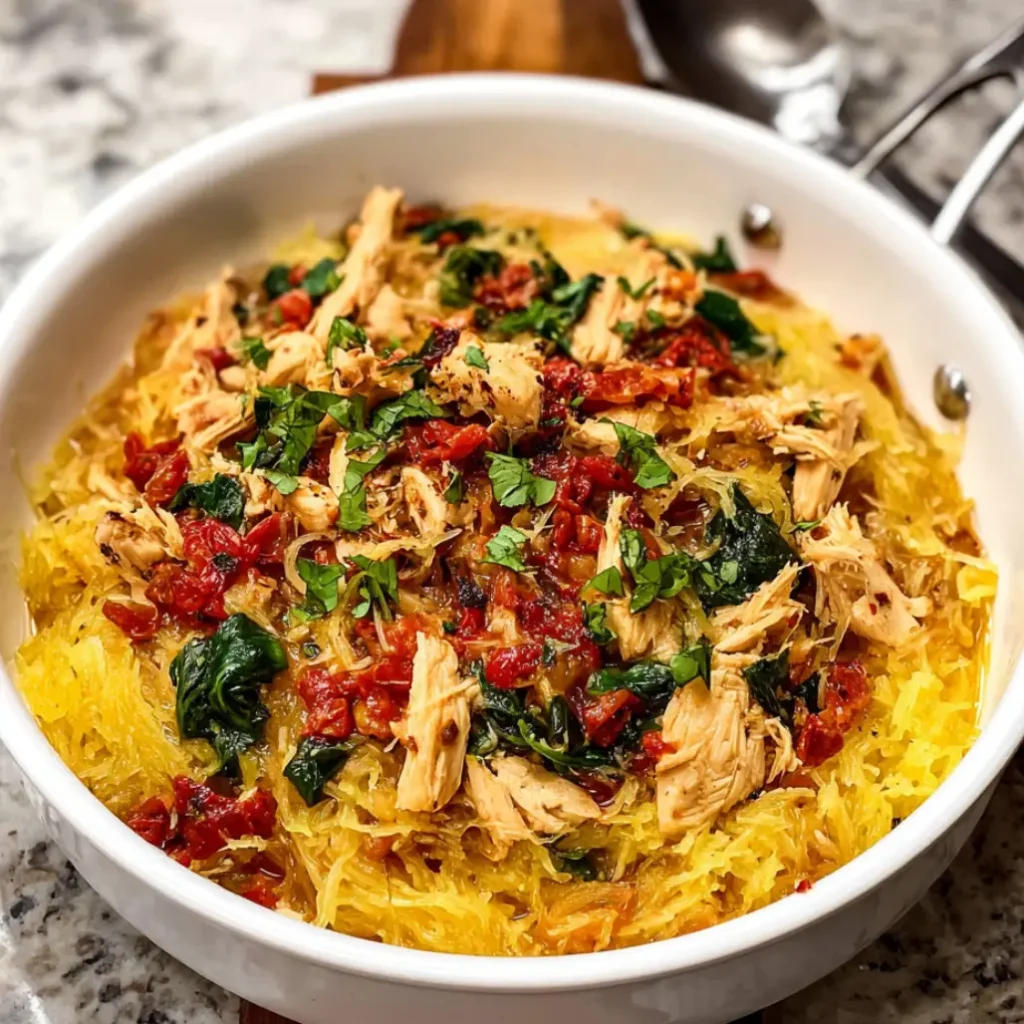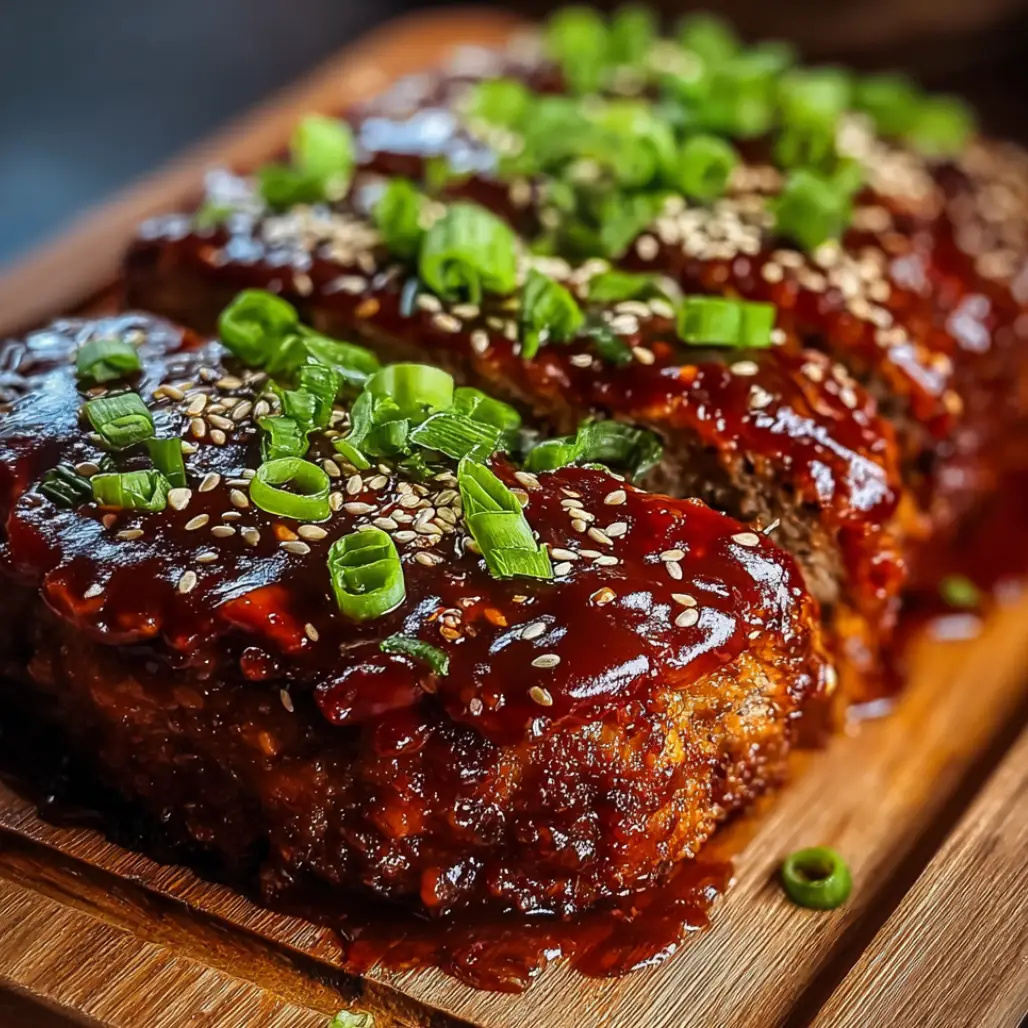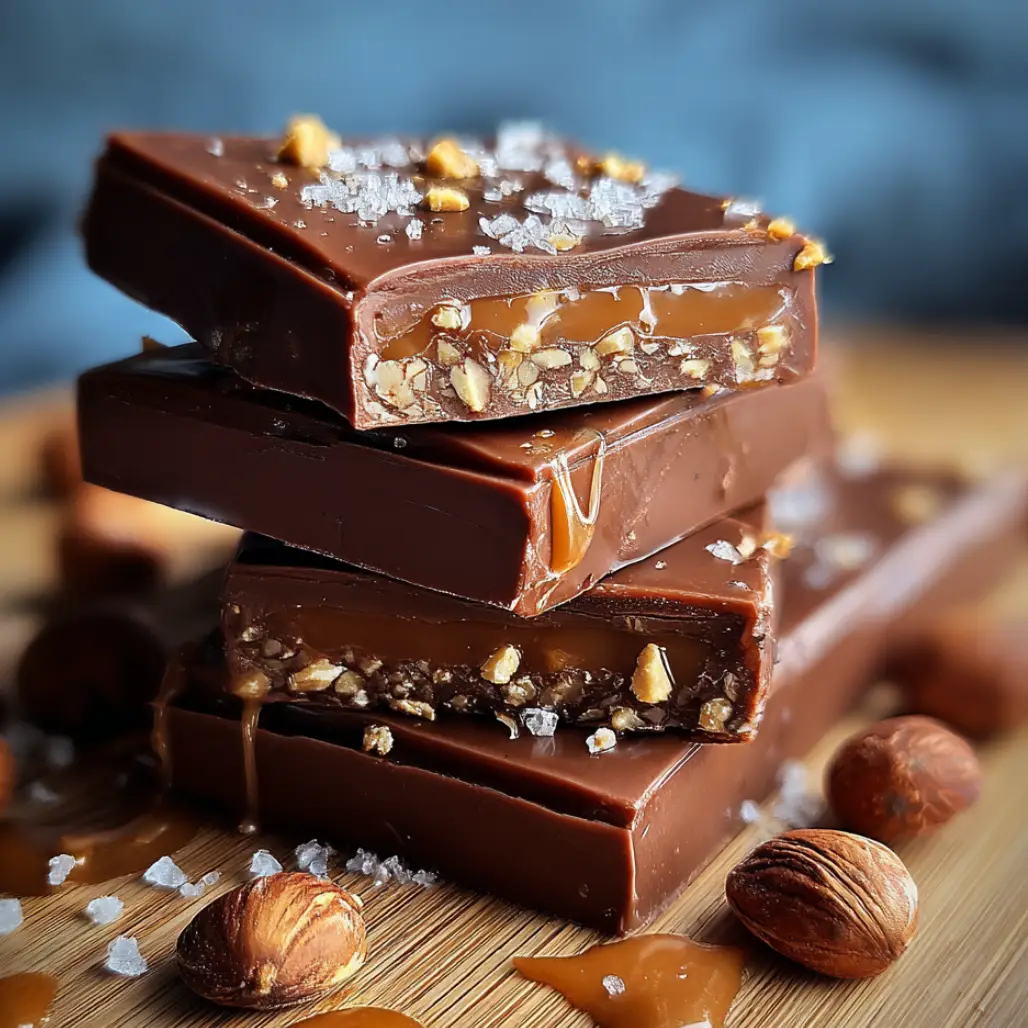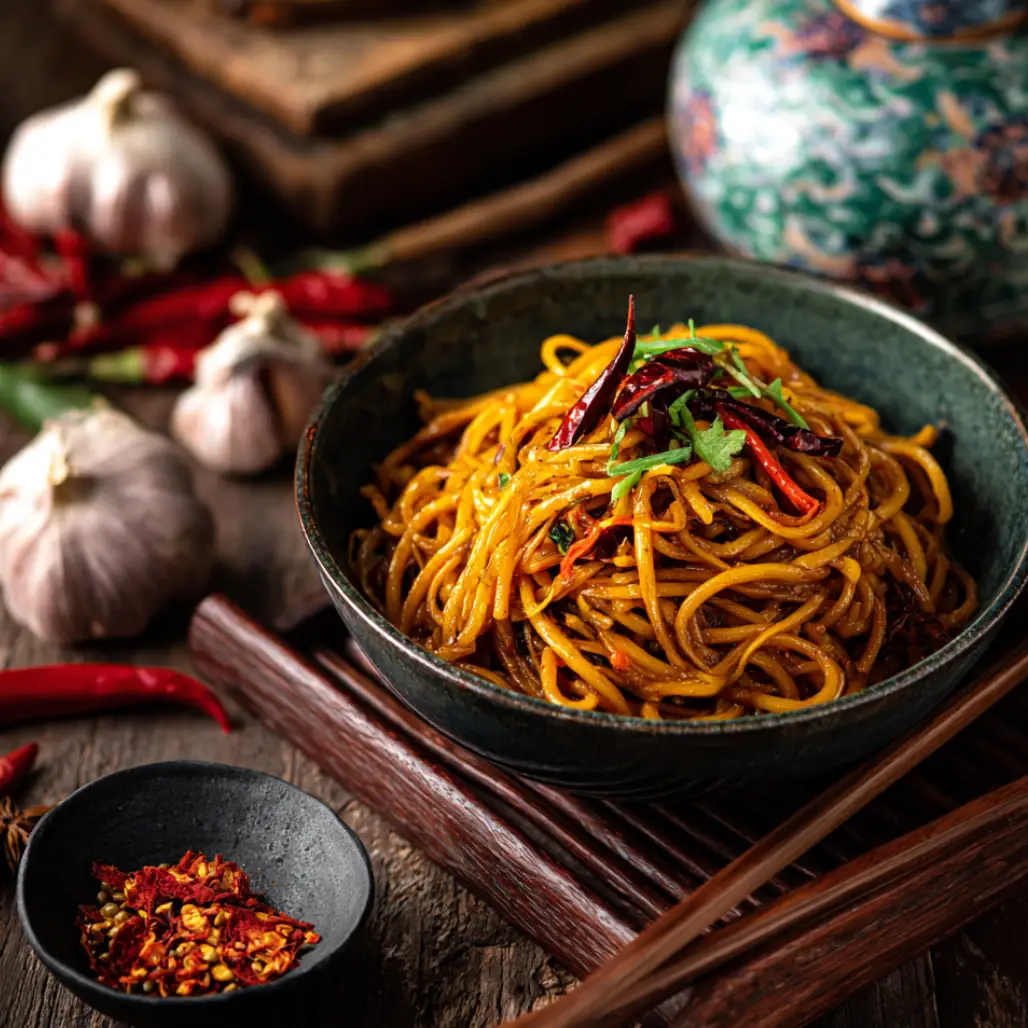| Prep Time: | 20 minutes |
|---|---|
| Cook Time: | 50 minutes |
| Total Time: | 1 hour 10 minutes |
| Serves: | 6 |
Transform your weeknight dinner routine with this incredible Tuscan chicken spaghetti squash that combines the rustic flavors of Italy with the health-conscious approach of modern cooking because this dish delivers all the satisfaction of traditional pasta without the heavy carbohydrates that can leave you feeling sluggish. The tender strands of roasted spaghetti squash create the perfect foundation for succulent chicken pieces bathed in a creamy, herb-infused sauce that features sun-dried tomatoes, fresh spinach, and aromatic garlic because these ingredients work together to create layers of flavor that transport you straight to the Italian countryside with every single bite.
This remarkable dish represents the perfect marriage of comfort and nutrition because it satisfies your craving for rich, creamy pasta while providing lean protein, abundant vegetables, and significantly fewer calories than traditional pasta dishes. The natural sweetness of the spaghetti squash pairs beautifully with the savory elements of the Tuscan-inspired sauce because this vegetable acts as a neutral canvas that absorbs all the wonderful flavors while contributing its own subtle nutty notes that enhance the overall complexity of the dish.
Why This Tuscan Chicken Spaghetti Squash Works
The magic of this Tuscan chicken spaghetti squash lies in its ability to deliver maximum flavor through carefully balanced ingredients that complement rather than compete with each other because the key to successful Tuscan cooking involves layering simple, high-quality ingredients in ways that allow each element to shine while contributing to a harmonious whole. The chicken provides substantial protein and savory depth because properly seasoned and seared chicken develops a golden crust that adds textural contrast while locking in natural juices that keep the meat tender throughout the cooking process.
The cream sauce serves as the unifying element that brings all components together because it carries the herb flavors throughout the dish while providing the luxurious mouthfeel that makes this meal feel indulgent rather than diet food. Sun-dried tomatoes contribute concentrated umami flavors and slight acidity that brightens the rich sauce because their intense flavor comes from the sun-drying process that removes moisture while concentrating all the natural sugars and compounds that make tomatoes so appealing.
Fresh spinach adds color, nutrition, and a subtle earthy flavor that balances the richness of the cream sauce because leafy greens provide essential vitamins and minerals while contributing a pleasant texture contrast that keeps every bite interesting. The garlic and herbs create the aromatic foundation that defines Tuscan cuisine because these ingredients have been used together for centuries to create the distinctive flavor profile that makes Italian food so universally beloved.
Essential Ingredients
For the Spaghetti Squash:
- 1 large spaghetti squash (approximately 3-4 pounds)
- 2 tablespoons olive oil
- 1 teaspoon salt
- 1/2 teaspoon black pepper
For the Tuscan Chicken:
- 1 1/2 pounds boneless, skinless chicken breasts, cut into bite-sized pieces
- 2 teaspoons Italian seasoning
- 1 teaspoon garlic powder
- 1 teaspoon salt
- 1/2 teaspoon black pepper
- 2 tablespoons olive oil
For the Creamy Tuscan Sauce:
- 3 tablespoons butter
- 1 medium shallot, finely diced
- 4 cloves garlic, minced
- 1/3 cup sun-dried tomatoes, chopped
- 1/4 teaspoon red pepper flakes
- 1/2 cup dry white wine (or chicken broth)
- 1 cup heavy cream
- 3/4 cup freshly grated Parmesan cheese
- 4 cups fresh baby spinach
- 2 tablespoons fresh basil, chopped
- 1 tablespoon fresh lemon juice
- Salt and pepper to taste
The Art of Creating Perfect Tuscan Chicken Spaghetti Squash
Mastering this dish requires understanding that each component demands different cooking techniques and timing because the spaghetti squash needs long, gentle roasting to develop its characteristic tender texture, while the chicken requires high-heat searing to create flavorful browning before finishing in the sauce. The key to success lies in properly preparing each element so they come together seamlessly because rushing any single step will compromise the final result and prevent you from achieving the restaurant-quality flavors that make this dish so special.
Temperature control throughout the cooking process ensures optimal results because the spaghetti squash must roast at a consistent temperature to cook evenly without becoming mushy, while the chicken needs immediate high heat to develop proper browning before the proteins have a chance to release moisture and steam instead of sear. The sauce requires careful attention to prevent curdling because cream-based sauces can separate if heated too aggressively or if acidic ingredients are added at the wrong temperature.
Understanding the science behind spaghetti squash preparation helps you achieve perfect results every time because this unique vegetable contains natural enzymes that break down cell walls during cooking, creating the pasta-like strands that make it such an effective substitute for traditional noodles. The roasting process caramelizes the natural sugars while evaporating excess moisture because this dual action intensifies the flavor while creating the ideal texture that holds up well when combined with the rich sauce.
Step-by-Step Instructions
Step 1: Prepare the Spaghetti Squash Foundation Preheat your oven to 400°F and line a large baking sheet with parchment paper because this prevents sticking while making cleanup effortless after the long roasting process. Carefully cut the spaghetti squash in half lengthwise using a sharp chef’s knife, then scoop out all the seeds and stringy pulp from the center cavity because removing this material prevents bitter flavors and allows for even cooking throughout the flesh.
Professional Tip: Pierce the whole squash several times with a knife and microwave for 2-3 minutes before cutting because this softens the tough skin and makes the cutting process much safer and easier.
Key Points: The squash should feel firm but yield slightly to pressure when properly roasted, and the strands should separate easily with a fork without being mushy or waterlogged.
Step 2: Season and Roast the Squash Drizzle the cut surfaces of the spaghetti squash with olive oil and season generously with salt and black pepper, rubbing the seasonings into the flesh because this ensures even flavor distribution throughout the vegetable. Place the squash halves cut-side down on the prepared baking sheet and roast for 40-45 minutes until the flesh is tender when pierced with a fork because the cut-side down position allows steam to build up inside, cooking the squash evenly while preventing the top from drying out.
Professional Tip: Test doneness by inserting a fork into the thickest part of the squash because properly cooked spaghetti squash should offer slight resistance while still being tender enough to shred easily into strands.
Key Points: The roasted squash should have a slightly caramelized appearance on the cut edges and should easily separate into spaghetti-like strands when scraped with a fork along the natural grain of the flesh.
Step 3: Prepare the Chicken for Cooking While the squash roasts, cut the chicken breasts into uniform bite-sized pieces and season them thoroughly with Italian seasoning, garlic powder, salt, and black pepper because consistent sizing ensures even cooking while proper seasoning creates flavor throughout the meat rather than just on the surface. Pat the chicken pieces dry with paper towels after seasoning because removing excess moisture promotes better browning and prevents steaming during the searing process.
Professional Tip: Allow the seasoned chicken to rest at room temperature for 15-20 minutes before cooking because this helps the meat cook more evenly and allows the seasonings to penetrate deeper into the protein.
Key Points: The chicken pieces should be roughly the same size to ensure uniform cooking, and the surface should appear dry and well-coated with seasonings for optimal flavor development during searing.
Step 4: Sear the Chicken to Perfection Heat olive oil in a large, heavy-bottomed skillet over medium-high heat until it shimmers but doesn’t smoke because the proper oil temperature creates immediate searing without burning the delicate seasonings. Add the seasoned chicken pieces in a single layer without overcrowding because proper spacing allows each piece to develop a golden-brown crust that adds both flavor and visual appeal to the finished dish.
Professional Tip: Resist the urge to move the chicken pieces immediately after adding them to the pan because allowing them to sear undisturbed for 2-3 minutes creates the best browning and prevents sticking to the pan surface.
Key Points: The chicken should develop a golden-brown crust on all sides and register 165°F on an instant-read thermometer when fully cooked, with no pink remaining in the center of the largest pieces.
Step 5: Build the Aromatic Sauce Base Remove the cooked chicken from the skillet and set aside, then reduce heat to medium and add butter to the same pan because using the same cooking vessel captures all the flavorful browned bits that will enhance the sauce. Add the diced shallot and cook for 2-3 minutes until softened and translucent because properly cooked shallots provide sweet, mild onion flavor without the harsh bite that can overpower delicate sauces.
Professional Tip: Scrape up any browned bits from the bottom of the pan while cooking the shallots because these caramelized proteins and seasonings add tremendous depth of flavor to the finished sauce.
Key Points: The shallots should be soft and fragrant without any brown coloring that would indicate burning, and the pan should maintain enough heat to create gentle sizzling without aggressive bubbling that could cause spattering.
Step 6: Develop Complex Flavors Add the minced garlic and red pepper flakes to the softened shallots, stirring constantly for 30-60 seconds until fragrant because garlic burns quickly and becomes bitter if overcooked, while this brief cooking time releases its aromatic compounds without destroying its sweet, nutty character. Stir in the chopped sun-dried tomatoes and cook for another minute because this brief heating helps to release their concentrated flavors into the oil and creates a more cohesive sauce base.
Professional Tip: Keep the garlic moving in the pan constantly because even 30 seconds of stationary contact with the hot pan bottom can cause burning that will create bitter off-flavors throughout the entire sauce.
Key Points: The garlic should become fragrant and lightly golden without any brown spots that indicate burning, while the sun-dried tomatoes should warm through and begin to release their oils into the pan.
Step 7: Add Wine and Build the Sauce Pour in the white wine and allow it to bubble vigorously for 1-2 minutes to cook off the raw alcohol flavor because this deglazing step also lifts any remaining browned bits from the pan bottom while adding acidity that will balance the rich cream. Gradually stir in the heavy cream and bring the mixture to a gentle simmer because adding the cream slowly prevents temperature shock that could cause the sauce to curdle or separate.
Professional Tip: If you don’t have white wine available, substitute with additional chicken broth and add a tablespoon of lemon juice because this combination provides similar acidity and flavor enhancement without the alcohol content.
Key Points: The sauce should simmer gently with small bubbles around the edges rather than a rolling boil that could cause the cream to break, and it should have a smooth, uniform consistency without any separation or curdling.
Step 8: Incorporate Cheese and Greens Remove the sauce from direct heat and gradually whisk in the Parmesan cheese in small handfuls because adding cheese off the heat prevents it from becoming stringy or grainy while ensuring smooth incorporation throughout the sauce. Add the fresh spinach and gently stir until wilted because spinach cooks very quickly and retains better color and texture when added at the end of the cooking process.
Professional Tip: Use freshly grated Parmesan cheese rather than pre-grated varieties because fresh cheese melts more smoothly and provides superior flavor and texture in cream sauces.
Key Points: The cheese should melt completely into the sauce without any lumps or strings, while the spinach should be wilted but still bright green and tender rather than overcooked and dark.
Step 9: Combine and Finish the Dish Return the cooked chicken to the sauce and gently stir to coat all pieces evenly because this final heating step allows the flavors to meld while ensuring the chicken is heated through completely. Stir in the fresh basil and lemon juice, then taste and adjust seasonings with salt and pepper as needed because these finishing touches brighten the flavors and provide the final flavor balance that makes the dish sing.
Professional Tip: Add the lemon juice gradually and taste after each addition because too much acid can overwhelm the delicate cream sauce, while the right amount enhances all the other flavors without being detectable as a separate element.
Key Points: The chicken should be heated through and well-coated with sauce, while the final seasonings should create a harmonious balance of flavors without any single element dominating the overall taste profile.
Step 10: Prepare and Serve the Spaghetti Squash Remove the roasted squash from the oven and allow it to cool for 5 minutes until safe to handle because hot squash can cause burns while being difficult to manipulate properly. Use a fork to scrape the flesh lengthwise to create spaghetti-like strands, working from the edges toward the center because following the natural grain of the squash creates the longest, most pasta-like strands that provide the best textural experience.
Professional Tip: Scrape gently but firmly to avoid breaking the strands unnecessarily because longer strands hold the sauce better and provide a more authentic pasta-like experience when eating.
Key Points: The squash strands should be tender but still have slight texture rather than being mushy, and they should separate cleanly without excessive moisture that would dilute the sauce.
Professional Tips for Success
Understanding proper timing ensures all components finish simultaneously because this complex dish involves multiple cooking processes that must coordinate perfectly to achieve restaurant-quality results. Start the spaghetti squash first because it requires the longest cooking time, then begin the chicken preparation during the final 20 minutes of squash roasting because this timing allows both components to finish at roughly the same time without either sitting and losing quality.
Temperature management throughout the cooking process prevents common problems that can ruin the dish because cream sauces are particularly sensitive to heat levels that can cause breaking or curdling. Keep the heat at medium or below once you add the cream because high temperatures will cause the proteins in the dairy to coagulate and separate, creating an unappetizing grainy texture that cannot be corrected.
For those interested in exploring complementary dishes, consider browsing our collection of perfect sides that pair beautifully with this rich main course because having lighter accompaniments helps balance the meal and prevents that overly full feeling that can come with such satisfying dishes. Quality ingredients make a significant difference in the final result because using freshly grated Parmesan, high-quality cream, and properly stored spices ensures the best possible flavor development throughout the cooking process.
Creative Variations to Explore
Transform this basic recipe into exciting new variations by substituting different proteins or vegetables that complement the Tuscan flavor profile because the creamy herb sauce works beautifully with numerous ingredients beyond the traditional chicken and spinach combination. Consider using shrimp instead of chicken because seafood cooks quickly and pairs wonderfully with the garlic and herb flavors, while requiring minimal adjustment to the cooking technique and timing.
Vegetarian adaptations work equally well because the rich sauce and substantial spaghetti squash create a satisfying meal even without meat protein. Replace the chicken with sliced mushrooms, artichoke hearts, or roasted vegetables because these ingredients provide umami flavors and interesting textures that complement the creamy sauce while adding nutritional value and visual appeal to the finished dish.
For those seeking lighter options, explore our salads section for inspiration on creating complete meals that balance rich main courses with fresh, crisp accompaniments. Seasonal variations keep the dish interesting throughout the year because summer versions might include fresh tomatoes and zucchini, while winter adaptations could incorporate roasted winter squash or hearty root vegetables that provide different flavors while maintaining the essential character of the dish.
Perfect Pairing Ideas
This rich, satisfying dish pairs beautifully with lighter accompaniments that provide contrast without competing for attention because the creamy sauce and tender chicken create such a complete flavor experience that complementary sides should enhance rather than overshadow the main components. A simple arugula salad dressed with lemon vinaigrette provides peppery bite and acidity that cuts through the richness because these contrasting flavors cleanse the palate between bites while adding fresh vegetable elements to the meal.
Wine pairings should complement the cream sauce and herb flavors because the right wine enhances the dining experience while providing acidity that helps digest the rich dairy components. Consider Pinot Grigio or Sauvignon Blanc because these crisp white wines provide citrus notes that echo the lemon in the dish while offering enough acidity to balance the cream without overwhelming the delicate herb flavors.
For additional beverage inspiration, explore our refreshing beverages collection because having lighter drink options helps cleanse the palate and prevents the meal from feeling too heavy. Sparkling water with lemon or cucumber provides a refreshing contrast that resets your taste buds between bites while supporting proper digestion of the rich meal components.
Discover More Italian-Inspired Delights
Expand your Italian cooking repertoire by exploring related recipes that share similar techniques or flavor profiles because mastering the basics of cream sauce preparation and herb combinations opens doors to countless other delicious possibilities. The skills you develop making this Tuscan chicken spaghetti squash translate directly to other classic Italian dishes because understanding how to balance cream, cheese, and herbs forms the foundation for numerous regional specialties.
Consider preparing garlic bread or focaccia because these traditional accompaniments provide textural contrast while offering opportunities to practice yeast baking techniques that complement your growing Italian cooking skills. Our snacks appetizers section offers numerous Italian-inspired options that can serve as starting courses for themed dinner parties or as components of larger Italian feasts.
For morning entertaining, browse our breakfast favorites to discover how Italian flavors translate to earlier meals because understanding these connections helps you create cohesive menu themes that showcase your developing expertise in this beloved cuisine. Building connections between different recipes helps you become more confident in improvisation while ensuring every meal feels intentionally planned and professionally executed.
Storage and Make-Ahead Guidelines
Proper storage techniques ensure this Tuscan chicken spaghetti squash maintains its quality for several days because the components can be prepared separately and combined when ready to serve, making it an excellent option for meal preparation and busy weeknight dinners. Store the cooked spaghetti squash strands separately from the chicken and sauce because this prevents the squash from becoming soggy while maintaining the proper texture of each component when reheated.
The complete dish will keep in the refrigerator for up to four days when stored in airtight containers because the cream sauce actually improves slightly in flavor as the herbs and spices continue to meld together over time. For reheating, warm gently in a covered skillet over low heat because aggressive reheating can cause the cream sauce to separate or the squash to become mushy and lose its pasta-like character.
Make-ahead preparation works particularly well for this recipe because you can roast the spaghetti squash up to two days in advance and prepare the chicken and sauce components separately, then combine everything quickly when ready to serve. This approach reduces stress during busy periods while ensuring optimal texture and flavor because each component can be prepared under ideal conditions without compromising quality for convenience.
The Science Behind Perfect Results
Understanding the scientific principles behind this dish empowers you to achieve consistent results because each component involves specific chemical reactions that require particular conditions to succeed optimally. The spaghetti squash develops its characteristic texture through the breakdown of pectin and cellulose during roasting because these structural compounds soften gradually under sustained heat while retaining enough integrity to create distinct strands rather than mushy pulp.
Cream sauce stability depends on maintaining proper emulsification between the fat and water components because cream contains natural emulsifiers that keep these elements combined under the right temperature conditions. Adding cheese off the heat prevents protein coagulation because excessive temperature causes the milk proteins to clump together and separate from the fat, creating the grainy texture that ruins cream sauces.
The Maillard reaction during chicken searing creates hundreds of flavor compounds because the interaction between proteins and natural sugars under high heat generates complex tastes and aromas that cannot be achieved through other cooking methods. This scientific understanding explains why proper searing technique is crucial for developing the deep, savory flavors that distinguish restaurant-quality dishes from ordinary home cooking.
Troubleshooting Common Issues
Even experienced cooks occasionally encounter problems with complex dishes like this Tuscan chicken spaghetti squash, but understanding common causes helps prevent most issues before they affect the final result because many problems stem from easily corrected technique errors rather than fundamental recipe flaws. Watery spaghetti squash usually results from overcooking or insufficient draining because this vegetable contains significant moisture that must be managed properly to prevent diluting the sauce.
If your cream sauce curdles or separates, remove it from heat immediately and whisk in a tablespoon of cold cream because this temperature shock often rescues broken sauces by re-establishing the proper emulsification. Prevention works better than correction, so always add cream gradually to hot mixtures and avoid boiling temperatures that guarantee separation because understanding these principles helps you maintain perfect sauce texture consistently.
Bland flavors typically indicate insufficient seasoning at various stages because each component should be properly seasoned individually before combining because this layered approach builds complex flavors throughout the dish rather than relying on final seasoning alone. Taste and adjust seasonings frequently during cooking because your palate provides the best guidance for achieving the flavor balance that makes this dish truly exceptional.
Additional Italian Cooking Inspirations
Continue your Italian culinary journey by exploring recipes that build upon the techniques mastered in this Tuscan chicken spaghetti squash because understanding fundamental approaches like cream sauce preparation and proper vegetable cooking opens possibilities for countless variations and related dishes. Consider risotto recipes that use similar cream and cheese techniques in different applications because these dishes share common principles while showcasing different grains and seasonal ingredients.
Pasta-making skills complement this recipe beautifully because understanding how to create proper sauce consistency and flavor balance applies equally to traditional wheat pasta and vegetable alternatives. You might also explore our flavored dips marinades section for inspiration on creating Italian-inspired appetizers that showcase similar herb and garlic combinations in different formats.
Bread-making techniques pair naturally with Italian cooking because fresh bread provides the perfect vehicle for enjoying rich sauces while developing yeast handling skills that appear in numerous Italian specialties. Building this comprehensive skill set helps you create complete Italian meals that showcase regional traditions while demonstrating your growing expertise in this beloved and diverse culinary tradition.
Conclusion
This Tuscan chicken spaghetti squash represents the perfect intersection of health-conscious cooking and indulgent flavors because it delivers all the satisfaction of traditional comfort food while providing superior nutrition and lighter calories that fit modern dietary preferences. The combination of tender roasted squash, perfectly seasoned chicken, and rich herb-infused cream sauce creates a dining experience that rivals any restaurant offering because attention to technique and quality ingredients transforms simple components into something truly extraordinary.
Mastering this recipe builds confidence for tackling other sophisticated dishes because the skills involved, from proper vegetable roasting to cream sauce preparation, form the foundation for countless other culinary adventures that can elevate your home cooking to professional levels. The investment in time and technique pays dividends not just in this immediate meal but in the knowledge and expertise that will serve you well in future cooking endeavors because understanding these fundamental principles opens doors to endless creativity and improvisation.
Whether you’re preparing this Tuscan chicken spaghetti squash for a special dinner party or simply want to create something extraordinary for your family, remember that cooking is fundamentally about transformation and care because taking the time to properly prepare each component and thoughtfully combine flavors demonstrates the love and attention that makes home-cooked meals so much more meaningful than any restaurant experience could ever provide.










